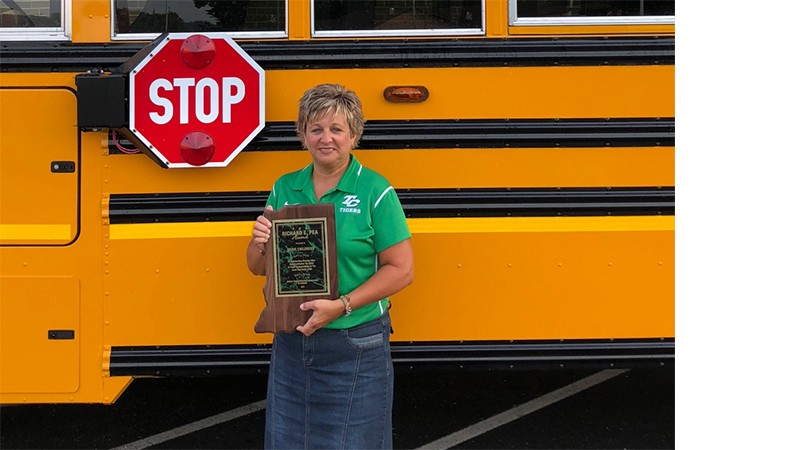Clients in the News: Indiana Student Transporter Childress Honored for Excellence
- Posted By: Robb Snyder
- Category Featured, Announcements

From School Transportation News
Written by Ryan Gray
July 3, 2018
The Student Transportation Association of Indiana (STAI) last month bestowed its 40th annual Richard Pea Award to Susie Childress, director of transportation for Northwestern Consolidated School District of Shelby County, for her contributions to pupil transportation at the local and state levels.
The late Richard Pea founded STAI and organized the first state conference at Brown County, Indiana in 1974. He also served as the director of School Traffic Safety for the Indiana Department of Education from 1974 until 1981. Childress received the award at a banquet sponsored by Midwest Transit Equipment on June 19, during the 44th Annual STAI Conference in Fort Wayne, Indiana.
Childress is an 18-year veteran of the school bus industry, first driving the yellow bus when her youngest son started school, she told School Transportation News. “I was on my way to pick up one of the kids from school when I passed a school bus and thought to myself, I can do that!”
She soon obtained her CDL, was assigned a route, and began driving her own children on extracurricular trips. “How about that,” she added, “getting paid to spend time with my kids and their friends.”
Childress’ employer Northwestern Consolidated Schools, a rural district located 20 minutes southeast of Indianapolis, promoted her to director of transportation 2008. It was a move she said made her nervous and unsure of herself at first, but she soon blossomed in the role. She worked with supportive superintendents, and as a result of the professional development courses she took through STAI, plus vendors such as Transfinder, which implemented a new routing program for the district three years ago.
“Building those relationships with other directors has proven most valuable. You know the saying, why try to reinvent the wheel? Chances are if I am facing a situation at our school regarding transportation, some of my neighbors have already been through it. I can reach out to them and see their approach on it,” she said. “After having a few years of experience as director, I hope I can now be a resource that new directors can call on.”
She said that what she misses most in overseeing the school district’s transportation operations is building personal relationships with all of the students on her bus, though she still continues to drive now and then. Northwestern Consolidated currently has all of its routes covered, but that wasn’t always the case. And as anyone in the industry knows, Childress added, that can quickly change.
“Unfortunately, the world we live in today does not allow for part-time employment, which is usually the title bus drivers get,” she observed.
Being small and rural, Childress said Northwestern Consolidated has encountered its own struggles with the national school bus driver shortage. She recalled that when she first started as a driver, the majority of her peers were either local farmers or, like she was, stay-at-home moms. “Over the years I have seen our new drivers transition to retirees looking for a second career. Those individuals are what I consider the cream of the crop,” she added. “They come from a generation that knows dedication and the importance of regular attendance. To top it off, who doesn’t need another grandma or grandpa?”
Another challenge Northwestern Consolidated faces is the new entry-level commercial driver regulations from the Federal Motor Carrier Safety Administration, which will go into effect in Feb. 2020.
“We currently have our own driver trainer on staff and hopefully will be able to continue with that practice. ... I am still waiting to see what those changes will be, so we will know how to plan,” she explained. “Our state transportation director, Mike LaRocco, has done a great job keeping the local directors up to date with the upcoming changes and what we can expect. My worry is that the new requirements will keep us from getting a potential driver in the driver’s seat quick enough to meet our needs as well as theirs.”



